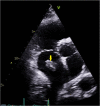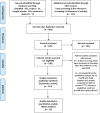Prevalence, Outcome, and Optimal Management of Free-Floating Right Heart Thrombi in the Context of Pulmonary Embolism, a Systematic Review and Meta-Analysis
- PMID: 36384306
- PMCID: PMC9677292
- DOI: 10.1177/10760296221140114
Prevalence, Outcome, and Optimal Management of Free-Floating Right Heart Thrombi in the Context of Pulmonary Embolism, a Systematic Review and Meta-Analysis
Abstract
Free-floating right-heart thrombus (FFRHT) in the context of a pulmonary embolism (PE) is a rare but serious encounter with no guidelines addressing its management. We performed a systematic review and meta-analysis addressing prevalence, clinical behavior, and outcomes of FFRHT associated with PE. Among the included 397 patients with FFRHT and PE, dyspnea was the main presenting symptom (73.3%). Obstructive shock was documented in 48.9% of cases. Treatment with thrombolytic therapy, surgical thrombectomy, and percutaneous thrombectomy was documented in 43.8%, 32.7%, and 6.5% of patients, respectively. The overall mortality rate was 20.4%. Syncope (p: 0.027), chest pain (p: 0.006), and obstructive shock (p: 0.037) were significantly associated with mortality. Use of thrombolytic therapy was significantly associated with survival (p: 0.008). A multivariate logistic regression model to determine mortality predictors revealed that syncope (OR: 1.97, 95% CI: 1.06-3.65, p: 0.03), and obstructive shock (OR: 2.23, 95% CI: 1.20-4.14, p: 0.01) were associated with increased death odds. Treatment with thrombolytic therapy (OR: 0.22, 95% CI: 0.086-0.57, p: 0.002) or surgical thrombectomy (OR: 0.35, 95% CI: 0.137-0.9, p: 0.03) were associated with reduced death odds. Meta-analysis of observational studies revealed a pooled prevalence of FFRHT among all PE cases of 8.1%, and overall mortality of 23%. Although uncommon, the presence of FFRHT in the context of PE is associated with high obstructive shock and mortality rates. Favorable survival odds are observed with thrombolytic therapy and surgical thrombectomy. Data are derived from case reports and observational studies. Clinical trials elucidating these findings are needed.
Keywords: free-Floating right heart thrombi; pulmonary embolism; right heart thrombi.
Conflict of interest statement
The author(s) declared no potential conflicts of interest with respect to the research, authorship, and/or publication of this article.
Figures
References
-
- Wendelboe AM, Raskob GE. Global burden of thrombosis: epidemiologic aspects. Circ Res. 2016;118(9):1340-1347. - PubMed
-
- Duffett L, Castellucci LA, Forgie MA. Pulmonary embolism: update on management and controversies. Br Med J. 2020;370:m2177. - PubMed
-
- Konstantinides SV, Meyer G, Becattini C, et al. 2019 ESC guidelines for the diagnosis and management of acute pulmonary embolism developed in collaboration with the European Respiratory Society (ERS). Eur Heart J. 2020;41(4):543-603. - PubMed
Publication types
MeSH terms
LinkOut - more resources
Full Text Sources
Medical




